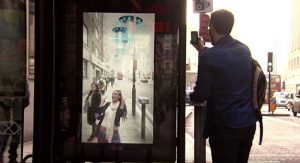Two decades into the 21st century, the out of home industry has seen a number of impressive advancements that have made the medium more effective and more efficient. From improving measurement to getting smarter, billboards have never been more relevant. No wonder they’re so in-demand.
We’ve compiled a list of the 10 biggest developments in outdoor advertising over the past 19 years. Understanding these trends help us anticipate what’s coming next and where your money is best spent when it comes to billboards.
1. OOH Revenue Growth While Other Media Fall
Who would have guessed, when the decade began with the big dot.com bust, that digital would rebound so quickly to put the squeeze on traditional media? Only one type of traditional media has thrived through that stranglehold — out of home. OOH advertising has risen, up 7 percent during third quarter of this year, according to the Outdoor Advertising Association of America, and well outpacing the growth of TV advertising.
Advertisers stick with what works. Clearly out of home retains reach and converts potential buyers into buyers, otherwise it wouldn’t maintain, much less grow, its revenue each year.
2. Advent of Social Media Makes Going Viral Easier

Twenty years ago, if you put up a buzzy billboard on the side of the road, you might reach a lot of people in a 25-mile radius, but your billboard wouldn’t go viral. No one even knew what “going viral” was. That changed when social media became an everyday pastime for most Americans.
Now we snap photos of ads we find amusing and share them on Facebook, Instagram and Snapchat. That gives a whole new audience to an ad you put in Los Angeles that people on the East Coast suddenly see — and it makes your money go a lot further when you buy out of home.
3. Improved Measurement of OOH Audiences

As the 21st century dawned, out of home measurement lagged way behind other media. Billboard buyers couldn’t be sure how many people saw their advertisements or which billboard viewers had the most desirable demographics.
The Traffic Audit Bureau developed ratings that were adapted industry-wide in the mid-2000s, and those have evolved and become an industry standard as TAB morphed into Geopath. Having reliable ratings allows for comparison between different media, making it easier to see the value in OOH, which has a much lower CPM than other traditional media.
4. Digital Billboards Become Accepted

In the early 2000s, as digital billboards moved from futuristic “Jetsons”-type technology to something adopted by dozens of states, the industry confronted a lot of unfounded fears about the safety of these boards. Critics charged they could distract drivers because of changing content. Yet that claim has been disproven many times.
Digital billboards are no more of a distraction or hazard than non-digital billboards. Once this was established, digital billboards’ growth has soared, to 8,800 in 2019 and forecast to rise even more as the 2020s begin.
5. Billboards Get More Interactive
Interacting with a captive audience has been one of the most winning aspects of digital advertising. It’s been hard to replicate for other traditional media, but not so for out of home. The advent of technologies like beacons, which can send messages to smartphones using Bluetooth capabilities, deliver a more personalized experience.
For instance, a beacon may invite people to enter a contest where they have to post a photo of themselves with a nearby advertisement. Or the beacon might send coupons for a nearby store. Allowing people to opt-in to these offers increases your odds of engaging, and not alienating, them.


6. Mobile Integrates With Billboards and Other OOH
The time people spend on their mobile devices has skyrocketed since 2000, up to nearly four hours a day. Much of that time is spent outside the home, whether you’re surfing the web while using public transportation or waiting for a movie to begin at the theater.
Thus integrating billboards with out of home advertising of all types makes sense. You can now text codes to a number advertised on a movie screen before the film to win free popcorn. Or you can load a mobile website advertised on a billboard. It’s user-friendly and convenient — two things that get your ad noticed no matter what the medium.
7. Projection Mapping Sparks Excitement

People love cool new things. Projection mapping has drawn attention as one of those hot areas people don’t really understand but they like watching. It allows advertisers to create 3D or 4D experiences, projecting interactive displays onto everyday objects like buildings or runways.
You can’t go more than a couple weeks without seeing a projection mapping experience go viral on social media. It delivers buzz that’s valuable to a client and allows those clients to stretch their creative muscle.
8. Using Data to Better Target Advertisements
 Any development that helps target advertising more effectively is a big one. Digital has upped advertisers’ expectations. They can see breakdowns of who they’re reaching and who they’re converting, and that has set a baseline for advertisers who want to see the same in other media.
Any development that helps target advertising more effectively is a big one. Digital has upped advertisers’ expectations. They can see breakdowns of who they’re reaching and who they’re converting, and that has set a baseline for advertisers who want to see the same in other media.

This works for out of home because you can target narrowly by choosing the right locations. Location can be the key ingredient in placement, in fact, because your customers are close to the point of purchase. Say you want to reach people going to Coachella who are likely fans of an artist performing there.
You can crunch the data to find a geographic location they are likely to pass that also matches up with the demographics of your artist’s fan group. Demographics have become so sophisticated you can practically target them by what they ate for breakfast.
9. More Programmatic Billboard Buying
Yes, the out of home industry has been slow to adapt some digital techniques. But programmatic, or automated, buying has become more common during the past couple years, and it will continue to revolutionize all media buying over the coming decade.
Buyers just need to be careful to still do their due diligence. Buying programmatically is not an asset if you buy a billboard no one can see because it sits behind a tree. Ride the boards before you buy to get better value.
10. Smart Billboards = More Relevant Messaging
The more interactive an experience, the greater the engagement. Billboards have become not only responsive but even predictive. They can react to weather or time of day to deliver pertinent

messages that draw people in. If you see an ad for an umbrella on a rainy day, you’re way more likely to pay attention than if you see an ad for an umbrella on a sunny day. New technology will help billboards keep getting smarter and make their messaging even more germane.
That’s our take on the biggest out of home developments of the last 20 years. We’d love to hear your thoughts, too. Get in touch or leave a comment below.

